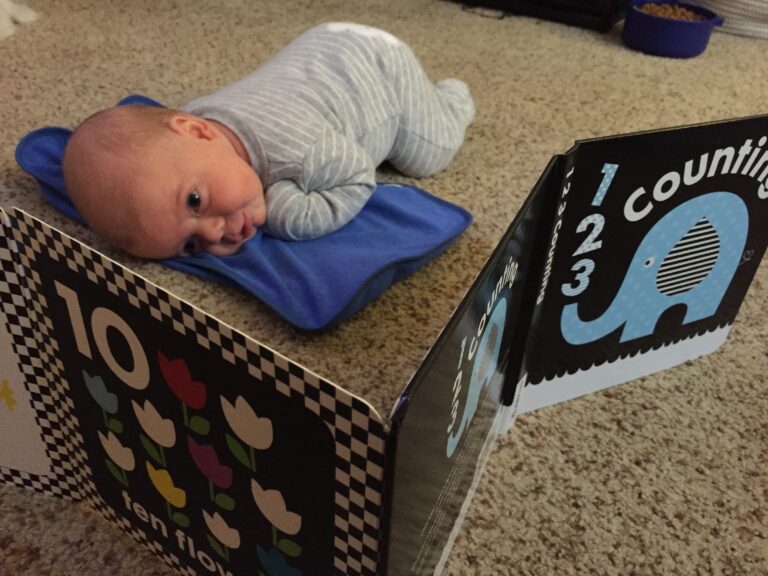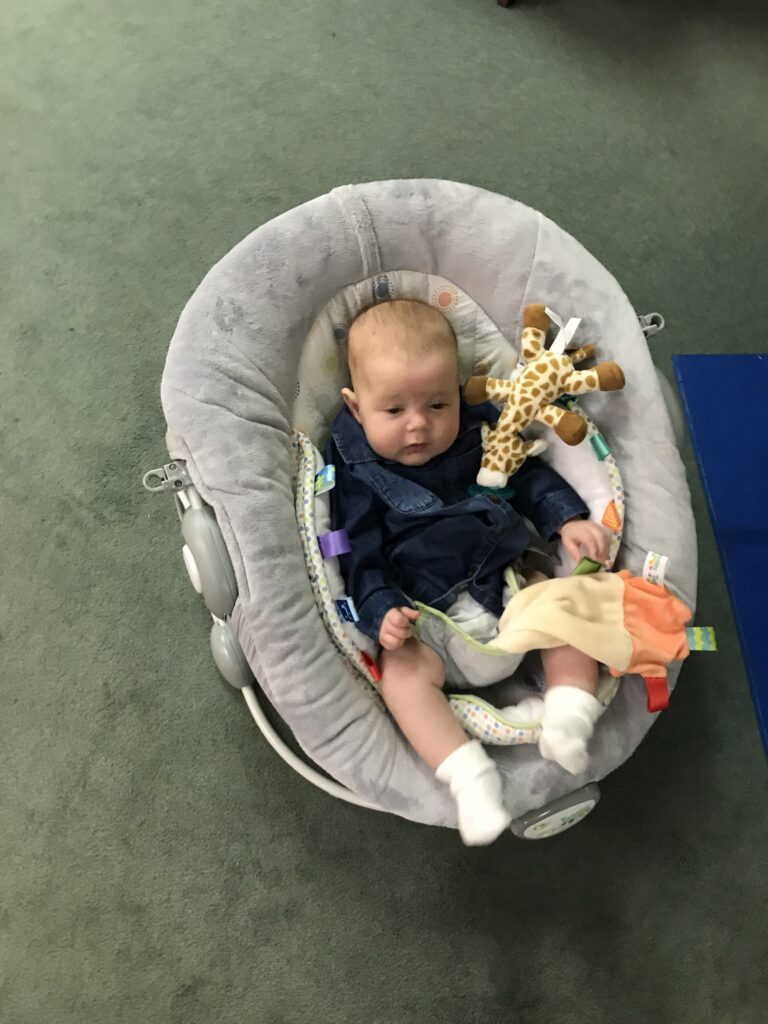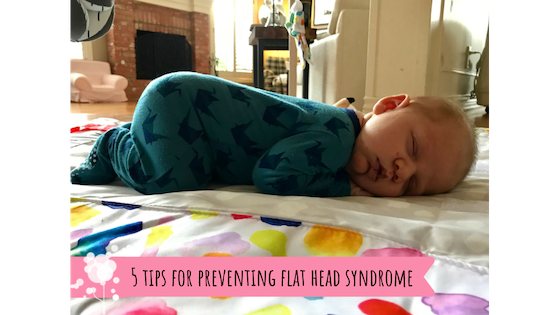Flat Head Syndrome, also known as brachycephaly or plagiocephaly, is one of the most common issues affecting babies – the incidence is estimated to be almost 50% of infants 7-12 weeks. The great news is that there are things you can do to prevent Flat Head Syndrome that are easy and don’t take much effort!

In no particular order, here are my 5 tips to reducing your baby’s risk of developing flat head syndrome:
1. Safe Sleep
The American Academy of Pediatrics (AAP) recommends that all babies sleep on a firm, FLAT surfaces, like a pack ‘n’ play or crib mattress, to reduce the risk of SIDS. But, this is also solid advice to prevent flat head syndrome. I recommend that babies spend very little time sleeping in swings or bouncy seats and little to NO time sleeping in rock n’ plays. These devices contribute to flat head syndrome because of their soft material that puts excessive pressure on the sides of your baby’s head. Rock n’ plays put too much pressure on the base of a baby’s head and can create a flat, vaulted shape on the back of the head. Car seats are essential to car safety, and you can’t really prevent baby from being in or sleeping in the car seat while in the car, but I do recommend not letting your baby sleep in the car seat when outside of the car. Not only does this increase the risk of developing a flat head, but it is also unsafe for your baby.
Babies spend A LOT of time sleeping, especially in the first few months of life, which is why the incidence of flat head syndrome in the early months is so high. You can’t reduce the number of hours your baby sleeps, but you CAN lower the risk of a flat head by making sure your baby sleeps on a flat, firm surface for naps and nighttime!

2. Tummy Time
It is no secret that tummy time is important for your baby’s developing motor skills, but you will be happy to know that it also serves another purpose – reducing the risk of flat head syndrome! As mentioned earlier, babies sleep a lot and you can’t always prevent pressure on baby’s head during sleep times. This means that wake time is the prime opportunity to decrease pressure on the back and sides of the head. Utilizing tummy time will give the back of baby’s head a nice break and allow you to practice some fun motor skills. You should aim to slowly increase the amount of time baby spends on her tummy. Follow this guide for tips on tummy time positioning and increasing baby’s tolerance!

3. Alternate Positions During Wake Times
So, what happens when your baby is awake for an hour, but can only tolerate 3-5 minutes of tummy time? Does that mean your baby has the spend the other 53-55 minutes on her back? No way! There are many alternate positions you can use to decrease the time your baby spends on her back. Sidelying, chest to chest, wearing baby in a carrier, using a boppy or pillows to prop baby up, and supported sitting are just a few other positions you can utilize to reduce the risk of flat head syndrome. Changing your baby’s position about every 5 minutes will keep your baby entertained and engaged and will help reduce fussiness!

4. Limit Time in “Containers”
I mentioned earlier about not sleeping in containers, but what about during wake times? My professional opinion is that you should limit wake times in swings, bouncy seats and rock n’ plays, too. Not only does it create pressure on baby’s head, but containers also prevent your baby from exploring normal movement patterns and practicing new motor skills. Most containers put your baby’s hips in a sustained flexed (or bent) position, limit hip movement and disengage the core muscles. Prolonged time in these devices can lead to not only a flat head, but also delayed motor skills. A great rule of thumb is to limit time in containers to 15 minutes at a time and no more than 1 hour total per day.

5. Alternate Feeding Positions
When you are looking to reduce the risk of your baby developing flat head syndrome, you have to look at ALL of the positions your baby is in throughout the day and assess the ones that are causing pressure on your baby’s head. It is common to think of sleeping and lying on the back as things that contribute to a flat head. But, it is also important to look at feeding times as well. Babies eat a lot, especially in the first few months, so if you are holding your baby in the same position for each feeding time, this could be increasing the risk for flat head syndrome in that particular area. The best way to reduce this risk is to alternate how you hold your baby for feeds. If you are breastfeeding, you likely alternate sides naturally. But, if your baby eats from a bottle, you should aim to hold baby in a different arm each time you feed. It might seem like feeding time is too short a period to make much difference, but multiple feedings a day, every day can really add up!
My baby has developed a flat spot! Now what?
What do you do if your baby has already developed a flat spot or develops one anyway, despite your best efforts? The good news is that most flat spots are reversible without an extraneous intervention like a helmet. The best way to advocate for your baby with a flat spot is to contact your pediatrician immediately and ask for a referral to a pediatric physical therapist who has experience working with flat head syndrome. Many pediatricians maintain the school of thought that babies will just “grow out of” a flat spot, but I encourage you to not let that excuse stop you from seeking professional help! Flat spots that occur despite your best efforts to prevent it are usually caused by an underlying issue – most likely a muscle imbalance (some muscles are tight and others are weak). A PT will be able to assess your baby’s muscles and find the underlying cause of the flat spot AND give you easy and practical tips to correcting the issue! In extreme cases, a corrective helmet might be needed. Check your state and insurance requirements because sometimes you do not need a pediatrician’s referral in order to see a PT!
For some helpful ideas while you wait to see the physical therapist, check out this guide with positioning tips for flat head syndrome!

Be the first to comment